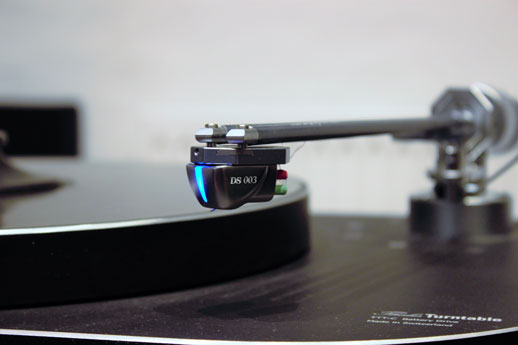The Vinyl Anachronist

by Marc Phillips
Part CXLVIII: 2022, Year of No Noise
(December 2022)
Other than me turning 60, not a lot happened to me in 2022. I did travel the world a bit for business--Germany, Denmark, The Netherlands and the UK--and so it was a whirlwind this spring and summer and it all went by in a flash. I'm getting more confident with my international sojourns and having more fun if I accept, in advance, that it's going to feel like the film The Martian where I must keep solving problems until I finally get to go home.
It was the lovely little country of Denmark where I stirred up some renewed enthusiasm for high-end audio, thanks to an innovative company called Audio Group Denmark and their three brands of gear: Borresen speakers, Aavik amplifiers and Ansuz cabling and accessories. I won't get into too much detail and tech here--I'll be finishing up reviews on all the gear they sent me through most of 2023 and publishing them on Part-Time Audiophile. Suffice it to say that AGD has such a unique approach to audio, and they're starting to get a lot of attention for it.
This is far from gimmickry or snake oil, and the folks at AGD even feel uncomfortable with the word innovative. What they're doing in Aalborg is constant testing, constant experimentation, and rigorous application of the scientific method. As a result, their advances are a combination of good engineering and a deep and eager dive into materials science. In fact, AGD has also partnered with the nearby University of Aalborg, where they have a particle accelerator. Most high-end audio companies don't have access to a particle accelerator.
Most of the company's research has focused on the electrical concept of inductance and how to reduce it in an audio system. Inductance is defined as "the property of an electric conductor or circuit that causes an electromotive force to be generated by a change in the current flowing." In plain-speak, that means there's a difference in the way current flows back and forth through the same path, and that difference creates noise. Some materials, like aluminum, aren't great at reducing inductance, and we tend to manufacture our audio equipment with giant heaps of aluminum. Iron, which composes a majority of power and output transformers, also creates similar inductance called 'eddy currents.' Those eddy currents, unfortunately, are audible.
The answer, of course, is better materials, such as stainless steel (better), or copper (better), or titanium (getting warmer!) and finally rare metals such as silver or gold or even zirconium. In Denmark, I held a one-kilogram rod of pure zirconium that cost 30,000 euros--and that doesn't count all the hassle from the Danish government because zirconium is used primarily in nuclear reactors. And you want to put it in what, a speaker cable? Sikker på at du gør det.
It seems crazy, but I've done endless comparisons now and it's all checking out. This stuff sounds incredible, endlessly detailed and musical and dynamic and all those other celebratory adjectives we use in high-end audio, and now I have to wrap my head around all this and presented it without looking like the front of my AGD T-shirt is stained with Kool-Aid. I'm only mentioning all this technical goo to remind you that we're still learning new things about getting good sound from our hi-fi systems. I am, at least. For instance, below I'll talk about a new type of phono cartridge, which is also attracting a lot of attention.
That's right--in 2022, we're still inventing new types of needles for our record players.
These latest technologies bring us, once again, to the 23rd Annual Vinyl Anachronist Awards for Analog Excellence.
DISCLAIMER: I'm thrilled that I'm getting exposed to all these fascinating new technologies when it comes to music playback, but I'll never stop spinning LP's.
New LP Release of the Year
.jpg)
It was just a couple of years ago when I declared Hilary Hahn's Paris as my favorite album of the year. I chose a classical album for several reasons. First, Paris contains an exquisite performance of Prokofiev's "Violin Concerto #1," which is perhaps my favorite concerto of all time. Second, this LP is on Deutsche Grammophon, one of those old and legendary classical music labels instead of a boutique audiophile label, and this pressing sounded phenomenal (back in the old days we called them Deutsche Grunge-ophon, but things have clearly changed). Finally, a lot of people loved Paris in the same way they'd love a brilliant classical album released back in the '50's, when music lovers still got excited about classical music. It was refreshing.
Her new album, Eclipse, has been sprinkled with the same brand of magic dust. Instead of Prokofiev, however, Hahn has focused on Dvorak's "Violin Concerto in A Minor," a piece I know but perhaps not as intimately. Add to that the Carmen Fantasy from Pablo De Sarasate and Alberto Ginastera's "Violin Concerto op.30" and it's giddy and strange and lush in a way that's hard to resist, thanks to the Frankfurt Radio Symphony led by Andres Orozco-Estrada. We can get still excited about new classic music releases. I can feel it.
Honorable mention must go to my friend Lyn Stanley's Novel Noel, the first Christmas album since A Charlie Brown Christmas. It's recorded with the same care and expertise as her Julie London albums from a few years ago, and these arrangements are wisely inventive and even deconstructive in a very pleasing way that doesn't make me want to jump off a bridge by December 24.
New LP Reissue of the Year

Which Beatles album got the big remastered box-set reissue in 2022? Revolver, which is considered the best Beatles album by far too many people. I guess I'm a late-career Beatles kind of guy, and I bow to the triumvirate of Sgt. Pepper, the White Album and Abbey Road. I even prefer Rubber Soul to Revolver. I couldn't even tell you my favorite song from Revolver without looking at the back of the album cover ("For No One," I'd suspect).
This lavish reissue, however, might change my mind. First of all, it seemed like Sgt. Pepper was the starting point for all these wonderful remasters, and that's 1967. That's probably because SPLHCB, with its endlessly ornate production values, really sounded great at the time. Go too far back into the Beatles' stereo catalog, you start hearing those dreadful mixes where the lead singer is sitting by himself in one channel, and the rest of the band is shoved into the other (that's why the mono versions of the early albums are usually worth more money).
Revolver was one of those recordings, and perhaps that's why I never championed it. But now, the stereo mix sounds full and balanced and open with plenty of low energy in the bottom octaves (I never understood why you'd have such a bass-shy sound when your bassist is so talented). Plus, you can buy the "new" Revolver in a countless number of formats and configurations, with extra discs and materials for the die-hard fans. It sounds great through a digital streaming service, but the LP's are simply more real, with a much clearer window into the original 1966 studio performances.
Cartridge of the Year

I didn't have a cartridge in mind for this year's awards--I only reviewed one during 2022 and it was $5,500, not normally the price point for a crowd favorite. Instead, I'm going to tell you about a new cartridge technology that's been around for a few years now, developed by DS Audio in Japan. It's called an "optical" cartridge.
No, this isn't like those laser turntables that operate more like a CD player than an ordinary TT. DS Audio optical cartridges don't have laser beams that read the grooves. With an optical cartridge, the needle still extracts the info from the groove. Normal moving-magnet and moving-coil speakers move, and the musical signal is recreated through changes in the magnetic field. An optical cartridge uses LEDs and photo cells to detect differences in light within the grooves.
Does it work? Yes, it works. I've had many people in the industry approach me to see if I've heard one of the five optical cartridges now in DS Audio's product line, and they always have that dazed, goofy look of someone who has just had an enormous sonic epiphany. These optical cartridges are good--so good, in fact, that the folks at Audio Group Denmark use one at the listening room in their factory. They're impressed. I'm impressed. Maybe this is the future of analog. We'll see in a couple years.
Turntable of the Year
For the last couple of years, I've been a man without a turntable. In last year's annual wrap-up, I had settled on a Technics SL-1210G to replace the SL-1200G I'd been borrowing for three years. I had already sold my two back-up turntables, the Unison Research Giro I used for a decade, and the lime-green Rega P3-24 I'd used for the years before the Giro arrived.
So what happened to the Technics? Well, I was in line for months. Supply chain issues have been hobbling the high-end audio industry, even though sales have been strong since the pandemic first appeared. Those months soon turned into a year, and then I realized I really needed that workhorse turntable, the one I depend on when I'm not reviewing something else. I had cartridges and phono stages and LP's to review, and I didn't have a single record player in the house. It was starting to become an issue.
An importer/distributor friend of mine in the industry, Michael Vamos of Blue Skies Audio, had the solution--a turntable from Pear Audio Blue. Pear Audio bases their turntable designs on the low-torque, heavy platter designs from Nottingham Analogue in the UK (I've talked about Nottingham favorably right here in this column). When Tom Fletcher of Nottingham passed away a few years ago, Pear Audio already had permission to use Fletcher's designs. So these great turntables live on.
Why did I pick the Pear Audio Blue Kid Howard (yes, it's a mouthful), with the Pear Audio Blue Cornet 2 tonearm, as my workhorse turntable? For just a bit more than the price of the Technics, I have a turntable that is simple, easy to set-up and reliable. In addition, the Pear Audio Blue turntables have a stellar reputation for great sound. Plus, it's just such an enjoyable table to use due to that heavy platter and that low-torque motor.
What does that mean, having a big heavy platter spun by the smallest motor that can achieve a constant speed? It's a good idea since bigger and more powerful motors also create bigger and more powerful vibrations. The Kid Howard is so fun to operate because you have to spin the platter with your hands to get it started until the motor is able to lock onto the right speed. To stop the heavy platter from spinning, you have to grab it and make it stop. There is no on/off switch--if it's plugged in, it's on. That appeals to the purist in me since this is about as close to a totally manual turntable as I can imagine. Of course I bought the Pear Audio Blue Kid Howard because it sounds so fantastic, however, which is exactly what I've been telling you to do for almost 25 years now.
Have a safe and music-filled 2023!